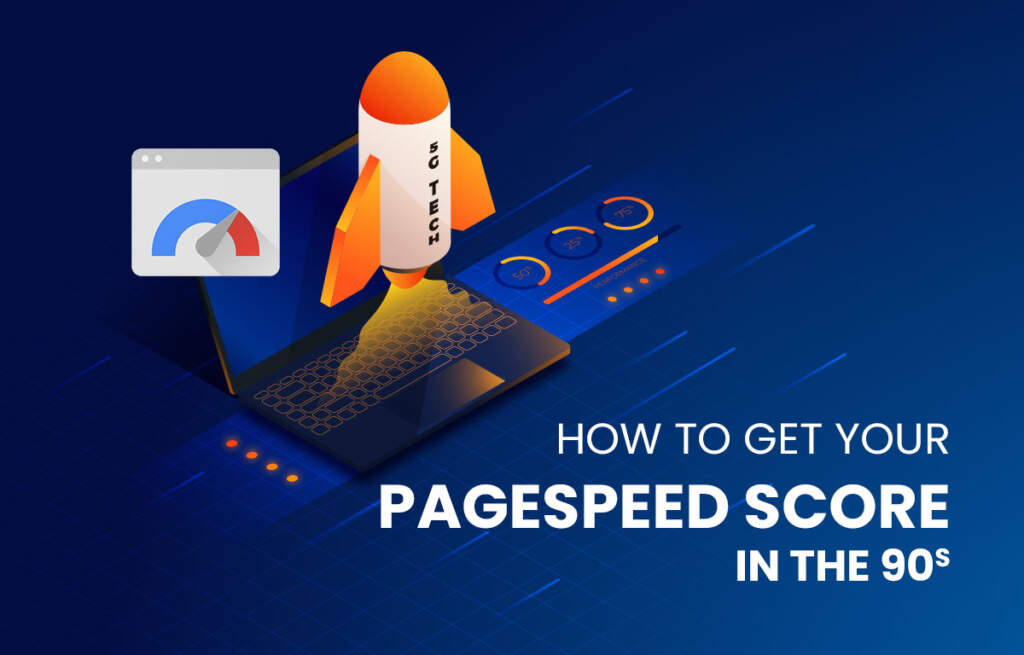The PageSpeed score on your website is a measure Google uses to review how well a site loads. A website with a higher PageSpeed will take less time to load, making it easier for customers to search for content. Your website will also be more likely to appear higher on Google search engine results because it’s more trustworthy and functional.
You can boost your PageSpeed score to reach the 90s by using a few measures. A score of 90 or greater is considered good, as your site will be more likely to appear on search engine results when it reaches that total.
How Do You See Your Current PageSpeed Score?
Before you look at how to improve your PageSpeed score, you have to see what the score is first. You can review your current PageSpeed score by going to pagespeed.web.dev and entering your URL. Click the Analyze button, and the program will review your page and produce scores based on these points:
- How well the site performs
- Accessibility
- Whether you’re using the best SEO practices
- How you’re creating a functional site without using potentially illegal SEO measures
The website can review how well your site performs on both desktop and mobile devices. You can also read the audit on the page to see how you can resolve your PageSpeed score.
Compress Content
One tip for how to speed up your website is to compress your page. You can use gzip compression to shrink your page sizes.
When your browser sends a signal to your server, the server will find the file and give you a compressed version. Your browser will then unzip the file and give you the full version. It’s easier for a browser to load and unzip a compressed site than if you didn’t compress the content, as the browser won’t spend as much time downloading the content.
Monitor Your Keywords
The keywords you use on your page can influence how your content appears on search engines. Be sure you optimize your keywords by spreading them around your site while avoiding keyword stuffing. Keep the relevant keywords in places like your URL or home page tag, and optimize whatever meta content you have throughout your site. Since you’ll have more identifying info for Google to analyze, you’ll be interpreted as having unique SEO content. This feature can improve your PageSpeed score because you’re providing enough content to Google.
Minify the Code
Minification is a useful process for helping you with your website performance optimization needs. Minifying entails shrinking your site code by removing unnecessary language or empty spaces in your site’s code. Resources like UglifyJS2 and HTML Minifier can help you clear out unnecessary content. These solutions can identify unique problems with your page and clear out anything you don’t require.
Focus On Above-the-Fold Content
Above-the-fold content is more important to your viewer than any third-party widgets you use. This content is the most important part of your site, as it is what users want to see the most. You can restructure your site code to allow the above-the-fold content to load first, providing a stronger performance.
Check any widgets or other content you use in your site, and put in your third-party content at the back of the line for how your site loads content. This measure helps you focus more on the native content you’ve created. Waiting until later for third-party items also helps because there’s always a potential a user might not have access to all those items needed for your site.
Optimise Your Images
The images you use on your page can influence your score and is the next part of this look at how to improve your PageSpeed score. Images that take too long to load or aren’t optimized well enough can harm your score.
You can compress your images and use file formats that don’t require as much data. You can also use a program like TinyPNG or ShortPixel to compress your data before it reaches your website. Proper compression is necessary for helping users load their data fast without spending too much time.
Reduce Redirects
Page redirects can harm your PageSpeed score. A redirect occurs when a user goes to one link and is then automatically sent to multiple locations before getting where one wants to go. Redirects hurt your PageSpeed score because it takes longer for the user to get to one’s target page.
Check on where page redirects appear when you complete an analysis of your site. Recode these parts of your site to remove these redirects. You can also avoid using redirects unless you have a particular event, like a site rebrand.
Optimise Your Server
Your last tip for how to improve website loading times is to review your server and see how well response times can work. The server response time is the time it takes for the server to load the first byte of content. A slower time to load that byte can negatively impact your PageSpeed score.
Your goal should be to reduce the number of milliseconds it would take for a page to load. You can review your server to see how its application logic works. You might have to make a few adjustments to the logic to get the site to work faster.
Another option is to update your server and provide additional memory or processing power to boost its performance. This measure works if you have an older server model that you haven’t updated in a while.
You can also implement a content delivery network that will move your page content across many servers. The system reduces how long it takes to deliver content from the server to your user, improving how well a page loads.
Conclusion
The work you put into your website is essential for helping you improve how your site appears on Google. You can get your PageSpeed score up in the 90s when you clear unnecessary content and reorganize how your site loads content. Be sure you also review your SEO work. Your strategies for adjusting your content can help you find a better PageSpeed score that shows your work is worthwhile.


